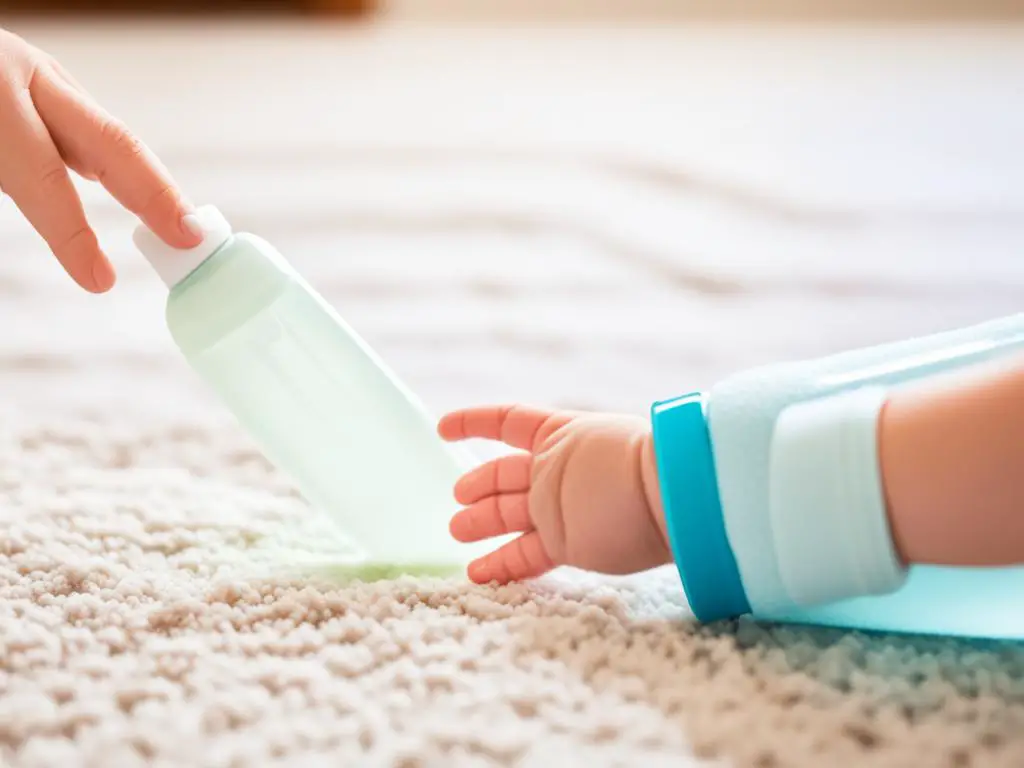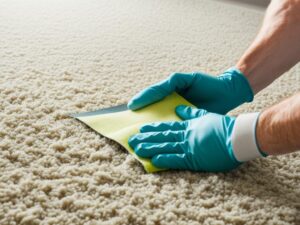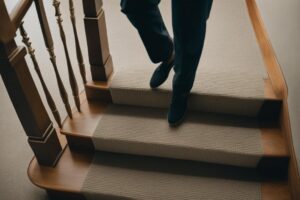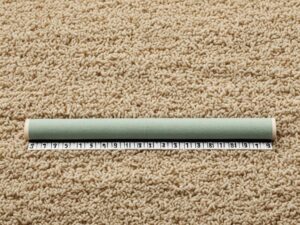Carpets are a popular flooring choice for babies as they provide a soft and comfortable surface for them to crawl and play on. However, carpets can also harbor dirt, mold, fungus, and bacteria, which can pose a risk to a baby’s health. It is important to sanitize carpets regularly to create a clean and hygienic environment for the little one. In this section, we will explore the best practices for cleaning and sanitizing carpets to ensure they are safe for babies.
Baby-safe carpet sanitization is crucial to protect your little one from potential health hazards. Follow these best practices for cleaning baby’s carpet:
Key Takeaways:
- Regularly sanitize carpets to remove dirt, mold, fungus, and bacteria.
- Implement preventative measures such as using doormats and regular vacuuming to keep carpets relatively clean.
- Opt for safe and non-toxic cleaning solutions such as vinegar, dish detergent, and club soda to remove stains.
- Read labels carefully when purchasing carpet cleaners to ensure they are baby-safe and free from hazardous chemicals.
- Prioritize the safety of your baby by choosing eco-friendly carpet sanitation methods and products.
Preventative Measures for Baby-Safe Carpet Cleaning
To ensure that your baby’s carpet remains clean and hygienic without the need for harsh cleaning chemicals, it is important to implement preventative measures. By taking proactive steps, you can maintain the cleanliness of the carpet and create a safe environment for your little one.
Here are some key preventative measures for baby-safe carpet cleaning:
1. Use Doormats
Placing doormats at entrances to your home is an effective way to prevent dirt, debris, and outdoor contaminants from being tracked onto the carpet. This simple step can significantly reduce the amount of dirt that accumulates on the carpet, minimizing the need for frequent deep cleaning.
2. Implement a No-Shoes Policy
Encourage family members and visitors to remove their shoes before entering the house. Shoes can track in dirt, oil, bacteria, and other substances that can quickly soil the carpet. Implementing a no-shoes policy helps to keep the carpet cleaner and healthier for your baby to play on.
3. Regular Vacuuming
Regular vacuuming is essential for maintaining the cleanliness of your baby’s carpet. Vacuum at least twice a week to remove dust, dirt, and allergens from the carpet fibers. Use a vacuum cleaner with a strong suction power and a HEPA filter, which can effectively eliminate dust mites and other contaminants.
4. Use Baby-Friendly Products
When it comes to cleaning the carpet, opt for baby-friendly cleaning products. Look for carpet cleaners that are specifically formulated to be safe for babies. These products are designed to effectively remove stains and odors without using harsh chemicals that could potentially harm your little one.
5. Protect High-Traffic Areas
High-traffic areas, such as where your baby plays or crawls, are prone to spills and messes. To protect the carpet in these areas, consider placing a blanket or a mat where your baby can play. This will help to contain any spit-up, diaper leaks, or snack messes, preventing them from seeping into the carpet fibers.
By following these preventative measures, you can reduce the frequency of deep carpet cleaning and minimize the use of harsh chemicals, creating a healthier and safer environment for your baby.
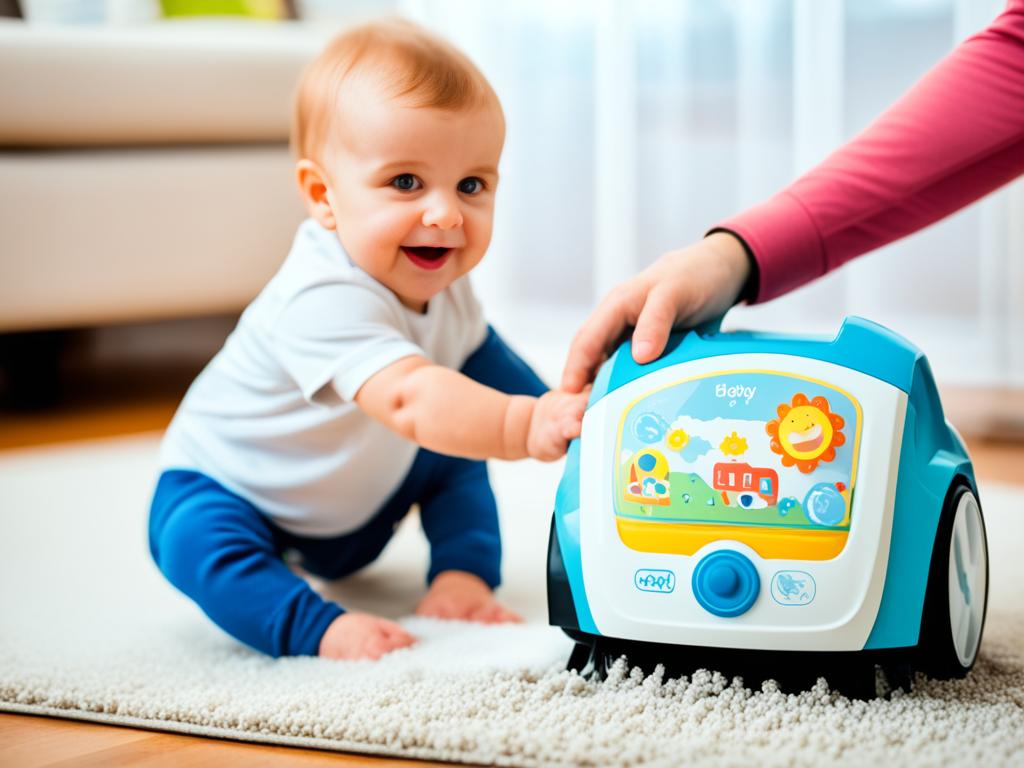
| Preventative Measures | Benefit |
|---|---|
| Using doormats | Prevents dirt and debris from entering the house |
| Implementing a no-shoes policy | Prevents the transfer of outdoor contaminants to the carpet |
| Regular vacuuming | Removes dust, dirt, and allergens from the carpet |
| Using baby-friendly products | Safely removes stains and odors without harsh chemicals |
| Protecting high-traffic areas | Prevents spills and messes from seeping into the carpet |
Safe and Non-Toxic Cleaning Solutions for Baby’s Carpet
When it comes to cleaning your baby’s carpet, it’s essential to prioritize their health and safety. Harsh chemical-based cleaning products can introduce toxic substances into your baby’s environment, so it’s best to opt for safe and non-toxic alternatives. By using common household items like vinegar, dish detergent, and club soda, you can effectively remove stains and messes without putting your baby at risk.
Vinegar is a versatile and natural cleaner that can eliminate odors and disinfect surfaces. Its acidic properties help break down dirt and stains, making it an excellent choice for carpet cleaning. To use vinegar as a carpet cleaner, mix one part white vinegar with two parts water in a spray bottle. Spray the solution onto the stained area, let it sit for a few minutes, and blot with a clean cloth or sponge. Repeat the process if necessary. The vinegar smell will dissipate as the carpet dries.
Dish detergent is another safe and effective option for cleaning your baby’s carpet. Choose a mild dish detergent that is free of harsh chemicals and fragrances. Mix a few drops of the dish detergent with warm water and apply the solution to the stained area. Gently scrub the carpet with a soft brush or cloth, working from the outside of the stain towards the center. Blot the area with a clean cloth to remove excess moisture and let it air dry.
Club soda is a great choice for tackling spills and stains on your baby’s carpet. Its carbonation helps lift stains and prevent them from setting. Start by blotting the spill with a clean cloth to remove as much liquid as possible. Then, pour club soda onto the stained area and let it sit for a few minutes. Blot the area gently with a clean cloth, repeating if needed. Once the stain is removed, press a dry cloth onto the damp spot to absorb any remaining liquid.
Using homemade carpet cleaners like vinegar, dish detergent, and club soda not only ensures a clean and fresh carpet but also provides peace of mind knowing that your baby is not exposed to harmful chemicals. Remember to spot test any cleaning solution in an inconspicuous area before applying it to the entire carpet to ensure it doesn’t cause any discoloration or damage.
Note: It is important to avoid using spot and stain removal products from the grocery store, as they often contain toxic chemicals that can be harmful to babies.
| Non-Toxic Cleaning Solutions | Benefits |
|---|---|
| Vinegar | – Natural and effective cleaner – Disinfects and eliminates odors – Breaks down dirt and stains |
| Dish Detergent | – Mild and safe for babies – Removes stains and grime – Free of harsh chemicals and fragrances |
| Club Soda | – Lifts spills and stains – Prevents stains from setting – Carbonation helps in the cleaning process |
Reading Labels for Baby-Safe Carpet Cleaners
When it comes to choosing a carpet-cleaning product for your baby’s carpet, it’s crucial to read the labels carefully. By doing so, you can ensure that the product you select is specifically designed to be safe for babies and free from hazardous chemicals.
Avoid products that are labeled as hazardous, dangerous, corrosive, or highly flammable, as these can pose a risk to your baby’s health. Look for carpet cleaners that use safe ingredients and have certifications indicating their baby-safe status. Reading labels is a critical step in safeguarding your little one’s well-being.
Here are a few key considerations when reading labels for baby-safe carpet cleaners:
- Check for certifications: Look for certifications such as eco-friendly or non-toxic to ensure that the product meets the necessary safety standards.
- Identify safe ingredients: Pay attention to the list of ingredients and avoid cleaners that contain harsh chemicals or known irritants.
- Review usage instructions: Ensure that the product is suitable for use on carpets and follow the manufacturer’s guidelines to achieve the best results.
Remember, your baby’s safety is of utmost importance when selecting cleaning products for their carpet. By reading labels and choosing baby-safe options, you can create a clean and healthy environment for your little one to play and explore.
“Reading labels is a crucial step in choosing carpet cleaners that are safe for your baby. It allows you to make informed decisions and avoid potential risks to your little one’s health.” – Dr. Emily Thompson, Pediatrician
By following these guidelines and taking the time to read labels for baby-safe carpet cleaners, you can ensure the well-being of your baby while maintaining a clean and hygienic environment. Always prioritize safe ingredients and certifications to create a baby-friendly space for your little one.
Key Factors to Consider When Reading Labels for Baby-Safe Carpet Cleaners
| Factor | Description |
|---|---|
| Certifications | Look for eco-friendly or non-toxic certifications to verify the product’s safety standards. |
| Ingredients | Avoid harsh chemicals or known irritants to protect your baby’s health. |
| Usage Instructions | Ensure that the product is suitable for use on carpets and follow the manufacturer’s guidelines. |
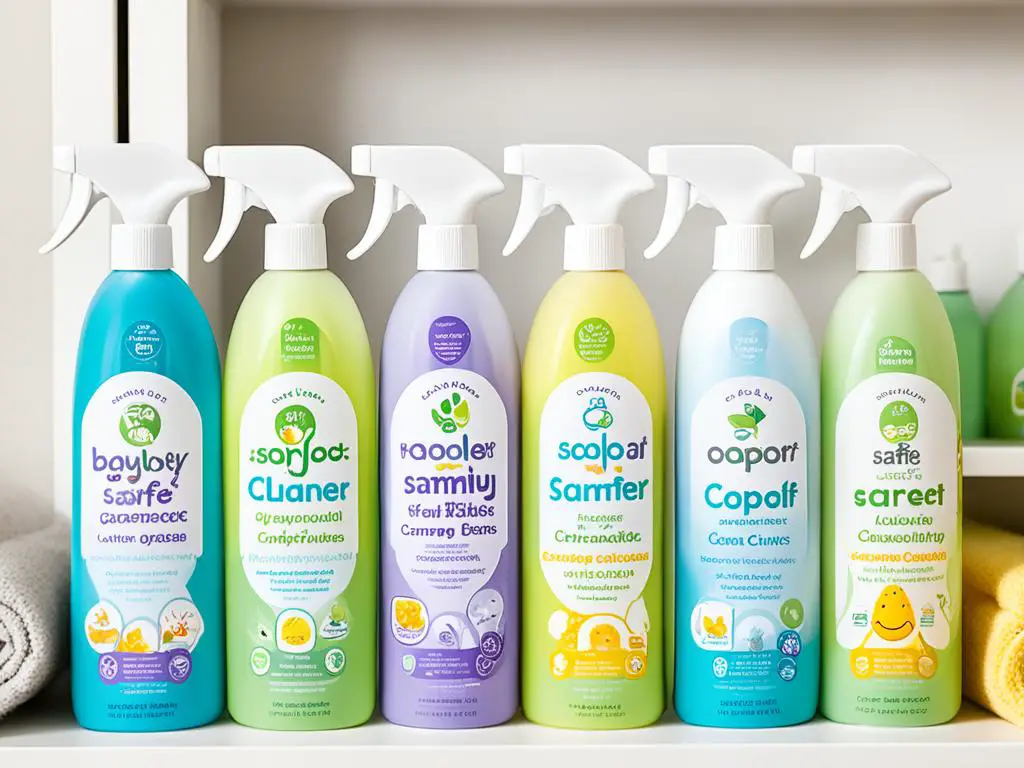
Conclusion
Ensuring the cleanliness and sanitization of your baby’s carpet is crucial for creating a safe and hygienic environment for your little one. By implementing preventive measures, using safe and non-toxic cleaning solutions, and reading labels for baby-safe carpet cleaners, you can maintain a clean carpet without compromising your baby’s health.
Regular maintenance, such as regular vacuuming and implementing a no-shoes policy, will help keep the carpet relatively clean and reduce the need for harsh cleaning chemicals. When it comes to dealing with stains and messes, opt for non-toxic cleaning solutions like vinegar, dish detergent, or club soda, which are safe for your baby.
When purchasing carpet-cleaning products, always read the labels to ensure they are specifically formulated to be safe for babies. Avoid products with hazardous chemicals and look for those with certifications indicating their baby-safe status. Prioritizing the safety of your baby is essential when choosing cleaning products and practices.
By following these baby-friendly carpet sanitization and safe cleaning practices, you can maintain a clean and hygienic carpet for your baby to crawl and play on, providing them with a healthy and safe environment to grow and explore.
